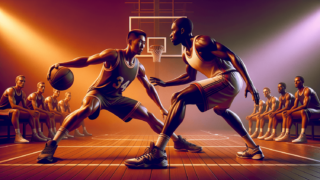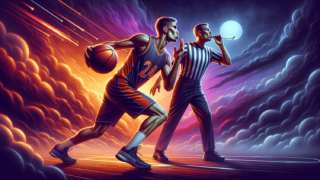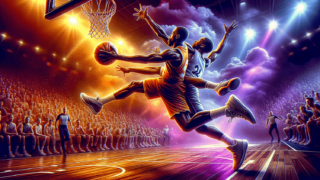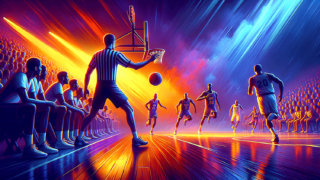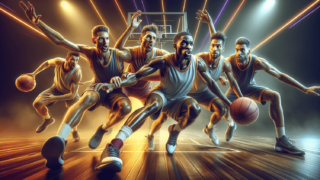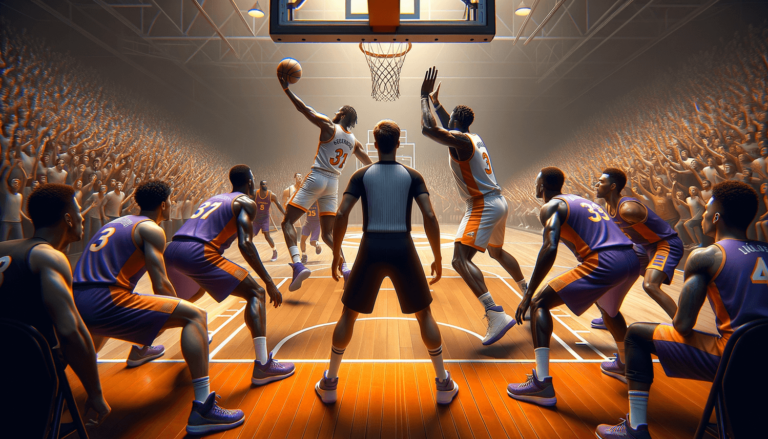
What’s a Technical Foul in Basketball?
Written by: Basketball Universe
Last updated:

Have you ever been watching a basketball game and suddenly, the whistle blows, the referee signals a specific gesture, and the commentator throws around the term “technical foul”? If you’re left scratching your head and wondering what just happened, then you’re in for a treat! Dive with us into the world of basketball as we explore the intricacies of a technical foul, a fascinating and vital aspect of the game. From unravelling its significance to understanding the different scenarios where it comes into play, this fun and professional blog post will leave you feeling like a true expert on the topic.
What’s a Technical Foul in Basketball?
A technical foul in basketball is a violation of the game’s rules, typically involving unsportsmanlike conduct, illegal tactics, or a range of other non-contact behaviors that disrupt the flow of the game. When a technical foul is called, the opposing team is awarded one free throw, and the game resumes with the same team retaining possession of the ball.
Understanding the Essence of Technical Fouls
As we dive into the world of basketball rules, it’s essential to grasp the concept of technical fouls and what sets them apart from their counterparts, personal and team fouls. Unlike personal fouls, which usually involve physical contact between players, technical fouls focus on the non-contact aspects of the game. This includes everything from unsportsmanlike conduct to illegal tactics that disrupt the flow and spirit of the game. So, without further ado, let’s explore different types of technical fouls and the circumstances in which they are called.
Unraveling Types of Technical Fouls
As you watch a basketball game, you may not realize that there are various categories of technical fouls. Let’s delve into each type and help you understand how they apply in different situations.
Player Technical Foul
Player technical fouls are the most common type of technical fouls called during a game. They are assessed against a player who engages in unsportsmanlike or disruptive behavior, such as:
- Taunting, trash-talking, or cursing at an opponent or referee
- Excessive complaining or arguing with officials
- Delaying the game intentionally
- Excessive swinging of the elbows or other unnecessary movement
When a player receives a technical foul, the opposing team is awarded one free throw, and the game continues with the same team possessing the ball.
Coach Technical Foul
Coaches are not immune to technical fouls either. A coach technical foul refers to a violation assessed against a coach or team personnel for behavior that violates the rules or disrupts the game, such as:
- Arguing excessively or disrespectfully with officials
- Entering the court without permission
- Using inappropriate gestures, language or conduct
Similar to player technical fouls, when a coach or team personnel receives a technical foul, the opposing team is awarded one free throw and retains possession.
Team Technical Foul
As the name suggests, team technical fouls are violations assessed against the entire team, rather than an individual player or coach. They typically result from a team’s illegal actions or tactics, such as:
- Having too many players on the court
- Failing to report a substitution within the required time
- Requesting an illegal timeout
As with the other technical fouls, when a team is charged with a technical foul, their opponents are awarded one free throw and retain possession of the ball.
Common Reasons for Technical Fouls
Now that we’ve explored the types of technical fouls in basketball, it’s important to know the specific circumstances and reasons that can lead to their call. Let’s review some of the most common scenarios in which technical fouls are issued.
Dissent, Disrespect, or Unruly Behavior
One of the primary reasons for a technical foul call is whenever a player or coach shows disrespect, dissent, or engages in unruly behavior. This can include taunting, using foul language, gesturing, or behaving aggressively toward officials or opposing players. Referees use their discretion in such cases and aim to maintain a respectful and orderly environment on the court.
Delay of Game
In basketball, maintaining the pace of play is crucial. A delay of game technical foul can be called if a player or team intentionally stalls the game or if they violate the league’s time limits on certain actions like inbounding the ball, shooting a free throw, or huddling around the coach. When a delay of game caused by a player is repeated, the consequences often lead to a technical foul.
Hanging on the Rim
While slamming dunks may be one of the most exhilarating parts of the game, players are prohibited from holding onto the rim for an extended period. A technical foul can be called for hanging on the rim, with some exceptions for safety reasons (such as avoiding landing on another player).
Illegal Defense
In some basketball leagues, specific rules govern the allowed defensive formations. In the NBA, for instance, illegal defenses have shifted over the years. Currently, it’s the defensive three-second violation that comes into play, where a defensive player cannot stay in the paint (the key) for more than three seconds without actively guarding an opponent. Failure to adhere to these rules may result in a technical foul.
Flopping
Flopping, or intentionally falling to the floor in an attempt to draw a foul, is considered unsportsmanlike and goes against the spirit of the game. Players who exaggerate or fake contact to deceive the referees may be assessed a technical foul for flopping.
Consequences of Technical Fouls
Technical fouls in basketball not only disrupt the game but also have consequences for the players, coaches, and teams involved. Understanding these consequences may help prevent technical fouls and maintain the respectful spirit of the game.
Free Throws and Possession
As previously mentioned, when a technical foul is called, the opposing team is awarded one free throw. Additionally, the team that was fouled retains possession of the ball. These penalties can affect a team’s momentum and potentially change the outcome of a game, so it’s essential to be aware of the consequences and avoid committing technical fouls.
Fines and Suspensions
Professional leagues like the NBA have strict policies on technical fouls, and players or coaches may be subject to fines or suspensions for repeated violations. The penalties can escalate based on the number of technical fouls accumulated throughout the season, potentially leading to hefty fines or even suspensions, depending on the severity.
Ejection from the Game
If a player or coach accumulates two technical fouls in a single game, they are automatically ejected. This ejection can severely impact a team’s performance, especially if the ejected individual is a key player or leader on the team. Avoiding technical fouls is essential to maintain team strength and improve their chances of success.
Preventing Technical Fouls
Now that you have a comprehensive understanding of technical fouls in basketball, it’s essential to recognize the importance of preventing such violations. The best way to avoid technical fouls is to foster a culture of respect, sportsmanship, and adherence to the rules. Here are some tips to help you and your team prevent technical fouls:
Know the Rules
To prevent technical fouls, players and coaches must understand basketball rules and regulations. By having a thorough knowledge of the game, you’ll be less likely to violate the rules inadvertently and commit a technical foul.
Maintain Composure
Keeping your emotions and reactions in check is critical to avoiding unnecessary technical fouls. Regardless of the game’s intensity, remember to stay composed and focus on the task at hand. While it’s okay to be passionate, it’s essential to exhibit control and respect for opponents, officials, and the game itself.
Communicate with Officials
When in doubt, don’t hesitate to approach the officials for clarification or guidance on any rules or regulations. By establishing a relationship founded on open communication and respect, you’ll be creating an environment where technical fouls are less likely to be called.
Practice Good Sportsmanship
Lastly, always practice good sportsmanship. Treat your opponents with respect, offer a helping hand, and maintain a positive attitude on the court. A friendly demeanor leaves little room for the controversies that often lead to technical fouls.
Having delved deeply into the intricacies of technical fouls in basketball, understanding the rules and violations will make the game more enjoyable for players, coaches, and spectators alike. Keep these tips in mind as you strive to prevent technical fouls, and always remember to have fun and appreciate the incredible sport of basketball.
Impact of Technical Fouls on Game Strategy
Technical fouls not only disrupt the game, but also affect the strategies employed by team coaches and players. Whether focusing on team dynamics or navigating the emotions of the match, understanding how technical fouls impact the game can make for smarter play and more informed decisions.
Adjusting Offensive and Defensive Strategies
When a key player has already received a technical foul, the coaching staff and players must adjust both offensive and defensive strategies to minimize the risk of the player accumulating a second technical foul and getting ejected. This might include reassigning defensive or offensive tasks, reducing aggressive plays or physical confrontations, and revisiting the team’s overall approach on the court.
Emotional Management
In some cases, players may use the occurrence of a technical foul to their advantage. Teams may attempt to provoke opponents into committing additional technical fouls or bait them into losing their cool, which can impact their performance. Coaches and captains should emphasize the importance of mental and emotional resilience when facing such challenges.
Managing Rotation and Playing Time
If a player is ejected due to two technical fouls, the coach must adapt their rotation and seek alternatives for filling the gap. This may provide an opportunity for other players to step up and showcase their skills, while also impacting the team’s overall minutes distribution and tactical approach.
Technical Fouls in Different Basketball Leagues
Basketball is played worldwide, and its popularity has given rise to numerous leagues beyond the NBA. As with any sport, the rules and regulations regarding technical fouls differ between leagues, making it essential for players and coaches to familiarize themselves with the specific guidelines of their respective competitions.
FIBA and International Play
In FIBA and international play, there are some differences in how technical fouls are handled. For example, while the NBA awards a free throw plus possession for a technical foul, FIBA allocates two free throws to the opposing team without granting possession. Additionally, FIBA employs a different ejection threshold, with automatic ejection occurring after a player accumulates one technical foul and one unsportsmanlike foul, or two unsportsmanlike fouls.
NCAA Basketball
The NCAA also follows its own set of rules and regulations, with some variations specific to a college-level game. While one technical foul carries the same penalty as in the NBA, two technical fouls result in automatic expulsion and a possible one-game suspension. The NCAA guideline is stricter when it comes to technical fouls committed by coaches, with only one technical foul leading to a single-game suspension.
Learning from Basketball Legends
Throughout the history of basketball, many of the game’s greatest players have accumulated technical fouls during their careers. Learning from these legends can provide insight into how to handle such situations and refine your on-court demeanor for a more elevated game.
Understanding Tolerance: Rasheed Wallace
A prime example of an exceptional NBA player with a substantial number of career technical fouls is Rasheed Wallace. He set a league record during the 2000-2001 season with 41 technical fouls—an unprecedented and still unbeaten number. However, it’s worth noting that Wallace’s overall talent on the court negated the potential strategic disadvantages created by his technical fouls. His career serves as a reminder of the importance of understanding the limits of one’s behavior and staying within the tolerable boundaries set by the league.
The Art of Composure: Tim Duncan
On the other end of the spectrum, Tim Duncan exemplified the benefits of staying focused and composed throughout his career. Despite being one of the NBA’s most dominant power forwards and fierce competitors, he rarely received technical fouls, which contributed to his team’s overall performance and championship-winning record. Emulating Duncan’s calm demeanor and mindfulness can help players minimize the chances of receiving a technical foul, ultimately benefiting their team and personal performance.
By exploring the nuances of technical fouls, learning from basketball legends, and adapting to the unique rules of various leagues, players, coaches, and enthusiasts alike can improve their understanding of the game and enjoy basketball even more. With this comprehensive knowledge of technical fouls in basketball, you’re well on your way to embracing the game’s excitement, intricacies, and competitive spirit.
Frequently Asked Questions
If you still have some lingering questions or need clarification on specific aspects of technical fouls in basketball, our FAQ section below covers ten common queries to help enhance your understanding of this vital part of the game. From coaching concerns to player behavior, we’ve got you covered!
1. How does a referee signal a technical foul?
When a referee calls a technical foul, they typically use the “T” hand signal. To make the signal, the referee forms the letter “T” by holding one arm horizontally while placing the other arm perpendicularly on top of it.
2. What is a double technical foul?
A double technical foul occurs when two opposing players or coaches are both assessed technical fouls for an altercation or unsportsmanlike conduct during the same play. Typically, in this situation, no free throws are awarded, and play resumes from where it was interrupted with the team in possession retaining the ball.
3. Can a team be assessed a technical foul during warm-ups?
Yes, a team can be assessed a technical foul during warm-up if its players or coaching staff engage in unsportsmanlike behavior, perform illegal dunks (in the NCAA), or fail to comply with warm-up time restrictions or other regulations. In such cases, the opposing team is awarded a free throw before the game officially starts.
4. What counts as an “illegal timeout”?
An illegal timeout occurs when a team requests a timeout when they have already used all of their allocated timeouts, asks for a timeout during a live ball situation when they don’t have possession, or attempts to call a timeout when the rules do not allow it. This violation results in a team technical foul.
5. How many technical fouls lead to ejection in the NBA and FIBA?
In the NBA, a player or coach is automatically ejected after receiving two technical fouls in a single game. In FIBA and international play, a player is ejected after accumulating one technical foul and one unsportsmanlike foul or two unsportsmanlike fouls.
6. Can a player receive a technical foul for their actions on the bench?
Yes, a player can receive a technical foul for their actions while on the bench. If they engage in disruptive or disrespectful behavior, such as taunting, arguing with the referees, or using inappropriate language or gestures, they may be assessed a technical foul.
7. How do fines and suspensions work for NBA players with multiple technical fouls in a season?
In the NBA, technical fouls often result in fines and suspensions for players who accumulate them throughout the season. As a player’s technical foul count increases, the penalties escalate accordingly, potentially leading to higher fines, suspensions, or additional disciplinary actions from the league.
8. Is there a limit to the number of technical fouls a team can receive in a game?
There is no specific limit to the number of technical fouls a team can receive during a game. However, since repeated technical fouls can lead to player or coach ejections, teams should strive to avoid such conduct and maintain control over their behavior.
9. Can a technical foul be rescinded or overturned?
In some cases, referees can discuss and overturn a technical foul call if they determine the violation did not occur, or if they mistakenly identified the player or coach involved in the infraction. However, once the game resumes, technical fouls are generally considered final and cannot be overturned.
10. How do coaches avoid technical fouls?
To avoid technical fouls, coaches should maintain professional conduct, display sportsmanship, and respect for the game. Communication with officials should be polite and controlled, ensuring they voice their concerns or questions in a respectful manner. Additionally, understanding league-specific rules, policies, and guidelines can aid coaches in avoiding behavior that may result in a technical foul.
Featured Posts
- No pillar pages found.
